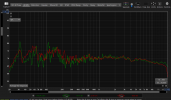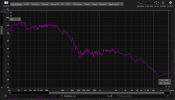Hi all. After spending a few days investigating this method, I have come to a rather sad conclusion:
I don't think it would work for this speaker, and in this room.
As I have explained in my previous post, the objective of this method is to correct the speakers so that they are flat with a nearfield measurement, which will then produce a falling Harman-like curve at MLP. The correction is obtained by subtracting the NF response from MLP.
I posted these curves yesterday. My "nearfield" measurement was taken 30cm from the speaker. Once it is subtracted from the MLP, the result is the Delta curve which shows a rising frequency response.
If you use this as your target curve, it should correct frequencies above Schroder to be flat, which it does. This is a really pleasing result, and it shows that
@joentell's method works as intended - it really does flatten the nearfield response.
(As an aside, I am having
issues with tweeter volume at the moment (see separate discussion), which is why there is a downwards step in the right tweeter (green line) above the XO frequency of 5kHz.)
However, when the verification measurement was taken from the MLP, I had a rising response in the upper frequencies. It sounds as bad as you would expect, see previous post for listening impressions.
This prompted me to ask myself why my speaker should produce a rising frequency response at MLP instead of a falling one, which one would expect. I exchanged some PM's with
@joentell, and he suggested that horn speakers like mine have an optimum distance where the sound "comes together", sort of a focal point if you like.
So today, I repeated the measurements. Just FYI this is the measurement setup:
View attachment 339025
You can see the size of the speaker. I lay a tape measure on the floor and proceeded to take MMM's at various distances. The volume of the speaker was NOT adjusted between all these runs of measurements. The result is below:
View attachment 339027
The idea behind doing this is to find the ideal distance to take "nearfield" measurements from. What I am looking for is the rate of change between curves to stop changing. If two subsequent measurements at different distances show no difference (apart from volume), then the "nearfield" is somewhere between those two measurements.
This is what I see:
- the volume of the tweeter (at about 15kHz)
remains the same even as the microphone gets further away from the speaker.
- the volume of the rest of the spectrum (100Hz - about 5kHz)
falls as the mic gets further away from the speaker. This is expected behaviour.
The combination of constant tweeter volume + falling midrange horn + woofer volume means that if the speaker is equalized to be flat at "nearfield", it will produce a rising frequency response as seen in the third graph. My reasoning is this: if it is flat at "nearfield", as you get further away, the
woofer + midrange horn drop off at a faster rate than the tweeter. This produces the rising response.
Conclusion: this horn loaded tweeter does not appear to behave the same way as a conventional tweeter in that it does not seem to lose much energy as the mic gets further away from it. I suspect that in this room, this speaker might even "come together" at a point behind the MLP, in other words there needs to be more distance between the MLP and the speaker.
So sadly, much as I love
@joentell's idea, I don't think that this system is a good candidate for it.






